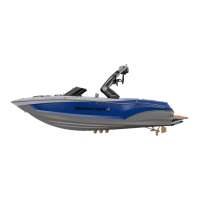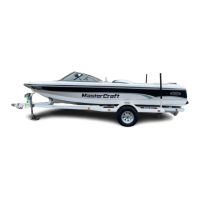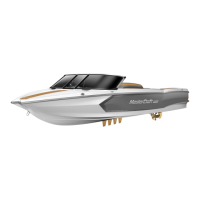337
/
2023 OWNER’S MANUAL
BASIC OPERATION
Shifing Gears
When shifting gears, always move the control lever smoothly
into gear. Do not hesitate. Slow gear engagement could damage
the shifting mechanism in the transmission.
NOTE: When shifting from forward to reverse or reverse to forward,
be sure to stop the control lever in the neutral position and
allow the engine to fall between 600-800 RPM before completing
the shift.
A one-hand, single-lever control operates as both a gear shifter
and a throttle. The lever automatically locks in the neutral position
(straight up and down) for safety. The lever can be moved from
neutral only by raising the umbrella lifter under the ball knob.
Shifting is accomplished by moving the lever forward or backward.
Center (straight up) is neutral. Moving the lever forward engages
the running gear; moving it back from center puts the drive train
into reverse.
Never attempt to shift without the engine running! This causes
excessive wear to the shifting mechanism and may negatively
aect control of the boat.
During regular warm-up of the engine, it is possible to temporarily
increase the engine RPMs without moving the boat. To accomplish
this, push in the button located at the bottom of the shift/throttle
lever with one hand and pull up the “umbrella” (umbrella lifter
under the ball knob). Move the lever to desired position and then
simultaneously release the button and umbrella. The engine will
run with increased RPMs and can be increased or decreased by
moving the lever. Returning the handle to the neutral position will
bring the system back to neutral and reduce the engine RPMs to
preset levels. This function should be done sparingly. Over-revving
the engine for any extended period can cause undue wear and tear
on the engine. Avoid advancing to wide-open-throttle and holding
the RPMs at that level.
Under Way
If the oil pressure gauge indicates low or no oil pressure,
immediately stop the boat as outlined below and check the oil
level. If the temperature gauge indicates overheating, stop the
boat when it is safe to do so as outlined below and check the raw
water system for blockage. (See the Boat Operations and Care and
Maintenance sections of this Owner’s Manual for directions on
how to properly check for the blockage.) DO NOT operate the boat
until the cause for the warning has been found and corrected.
Continued operation after the warning light has illuminated may
cause severe engine damage. This will void your warranty.

